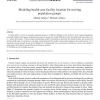Free Online Productivity Tools
i2Speak
i2Symbol
i2OCR
iTex2Img
iWeb2Print
iWeb2Shot
i2Type
iPdf2Split
iPdf2Merge
i2Bopomofo
i2Arabic
i2Style
i2Image
i2PDF
iLatex2Rtf
Sci2ools
COR
2008
2008
Modeling health care facility location for moving population groups
Locating public services for nomadic population groups is a difficult challenge as the locations of the targeted populations seasonally change. In this paper, the population groups are assumed to occupy different locations according to the time of the year, i.e., winter and summer. A binary integer programming model is formulated to determine the optimal number and locations of primary health units for satisfying a seasonally varying demand. This model is successfully applied to the actual locations of 17 seasonally varying nomadic groups in the Middle East. Computational tests are performed on different versions of the model in order analyze the tradeoffs among different performance measures. 2006 Elsevier Ltd. All rights reserved.
| Added | 25 Dec 2010 |
| Updated | 25 Dec 2010 |
| Type | Journal |
| Year | 2008 |
| Where | COR |
| Authors | Malick Ndiaye, Hesham K. Alfares |
Comments (0)

